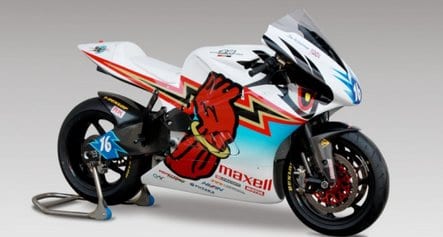Today, a new world record was established for electric motorcycles at the Isle of Mann TT; and it’s only qualifying day.
The Mugen Shinden San team set a new average lap speed of 186.5kmh, putting them only 23kmh behind the outright lap record speed of 209km. This lap was a huge 20 seconds faster than last years best electric lap, at 19min 35sec and around 2min behind the fastest ever lap by course legend John Guinness (on a CBR1000RR), who also happens to be theMugen Shinden San pilot for 2014.
What is most remarkable however is the rate and pace of advancement in electric bikes at this event, now in its fifth year of running.
In 2009, the inaugural lap record speed for the Agni electric bike was 140.7kmh; equivalent to the time that a 500cc Manx Norton achieved in 1936. However, in just 5 short years electric motorcycles have advanced to speeds that are equivalent to those set in 1981 by a Honda 1000 and just a smidgen faster than the ferocious Yamaha TZ750 two stroke. For those of you unfamiliar with the legendary TZ750, it was a bike that had a tendency to scare the living crap out of people. It delivered a ferocious burst of power in a small power band and was housed in a chassis that simply wasn’t up to the task. Every boy of the era dreamed of being able to ride and tame this machine and matching its speed is a pretty significant milestone in this young boy’s books. I simply couldn’t have conceived that by the time I was grown up a glorified starting battery coupled to a smart electric flymo motor would achieve the same results.
Using the TT speeds as a benchmark, electric motorcycle performance has effectively achieved in 5 years what it took internal combustion engined bikes 45 years to achieve. On average, electric bikes evolve 9 years for every 1 year of development, compared to their peers.
If the average pace of development continues, by 2016 electric motorcycles could challenge the outright speed of internal combustion engined bikes.
Now while this is exciting for rev heads, it has far more profound implications for the real world because the development, investment and lessons learned on the race track do translate into street machines. Nothing focuses attention better than being able to claim a new record or a prestigious silver trophy and right now we have a fantastic mix of small teams who reckon they can innovate their way to great results competing with the might and money of one of the worlds largest automotive developers.
Indeed, valuable lessons in reliability in battery pack technology are emerging in street bikes with both capacity, energy density and higher power cells becoming more common. Most teams are also using advanced oil cooled three phase motors which is one of the keys that allows them to deliver massive amounts of energy; around 100kW/220NM in the case of the Honda Mugen (how does 800 Amps hit you!).
What’s great about racing on a tough circuit like the Isle of Man is that whilst power and speed are important, range and power delivery are equally crucial and this will reap great rewards for mere mortals too. Some of the top US developers have apparently been assisting Mugen Shinden San to develop new control systems which will undoubtedly be more sophisticated, lighter and more compact, and have helped increase the effective storage capacity on board which equals more range.
Understanding how to accurately control energy flows and squeeze more out of battery packs will translate into better road bikes and cars and ultimately will also flow on into home based storage systems and better home integration technology.
Keep your eyes peeled for the results over the coming days and watch a little history being made.
Source: Solar Business Services. Reproduced with permission.









